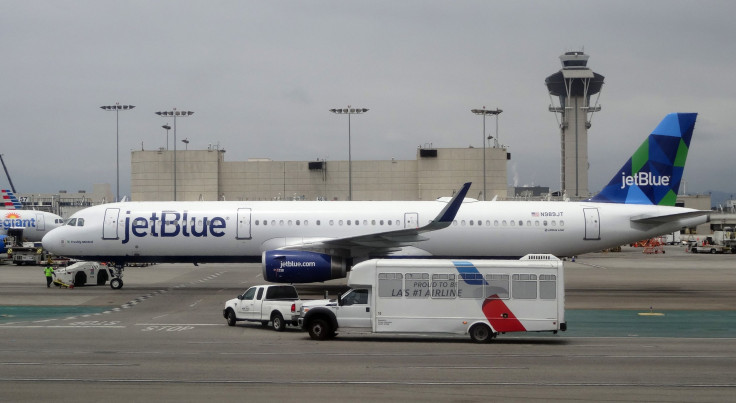Airline News: JetBlue Continues Its Aggressive Growth In Boston

JetBlue Airways (NASDAQ:JBLU) began flying to Boston 15 years ago, operating a handful of flights each day from a single gate. Since then, it has grown rapidly in Boston, capitalizing on service cuts by the legacy carriers around the time of the Great Recession. JetBlue is now the largest airline at Logan International Airport, with more than 150 daily departures and roughly 30% market share.
However, JetBlue sees room to make further market share gains in Boston. Meanwhile, it faces a growing challenge from Delta Air Lines (NYSE:DAL), which has become a strong No. 2 in that market. As a result, JetBlue plans to add a slew of extra flights on key routes later this year.
Slugging It Out With Delta
While Delta Air Lines has its main Northeast hub in New York, it sees the Boston business travel market as a big opportunity. JetBlue may have the most daily flights there, but Delta and its international joint venture partners can offer one-stop service from Boston to much of the world. That's an important selling point for business travelers.
In the past couple of years, Delta has expanded rapidly in Boston to exploit this opportunity. It will get five additional gates at Logan Airport this year and plans to launch new routes to several key business markets: Cleveland; Chicago; Newark, New Jersey; and Washington, D.C.'s Reagan Airport. Delta will also begin seasonal service to Edinburgh, Scotland, and Lisbon, Portugal, and add frequencies on a handful of existing routes.
Of course, JetBlue hasn't been standing idly by. Last September, it eliminated numerous short-haul flights at its Long Beach, California, focus city. Much of the capacity was reallocated to support additional flights from Boston and New York to Southern California.
At an investor meeting last fall, JetBlue said that it planned to make further cutbacks on underperforming routes while doubling down in its core markets, particularly Boston. In the next step of its network reallocation, it began flying from Boston to Rochester, New York, last month and added extra flights on nine routes from Boston to Florida and the Caribbean. Now the carrier is ready to respond to Delta's latest growth initiative in Boston.
JetBlue Looks To Solidify Its Lead
This summer, JetBlue will gain access to two more gates at Logan Airport, part of a gradual expansion of its footprint from 24 gates today to 30 gates by 2021. It will use this extra space to improve its flight schedule in Boston relative to Delta Air Lines.
On Wednesday, JetBlue announced that it will add frequencies on its routes from Boston to a dozen destinations: Austin, Texas; Charleston, South Carolina; Chicago; Cleveland; Detroit; Nashville, Tennessee; Newark, New Jersey; Orlando, Florida; Philadelphia; Raleigh-Durham, North Carolina; Savannah, Georgia; and Washington, D.C. Half of those cities are set to get new or expanded Delta Air Lines service to Boston at some point this year.
Most notably, JetBlue will institute near-hourly "shuttle" service to New York and Washington, D.C. in a bid to capture even more business traffic on those routes. JetBlue already offers 10 or 11 daily round-trips most days between Logan Airport and Reagan Airport, but there are some big gaps in its schedule in the late afternoon and evening. Going forward, it will add up to four additional daily round-trips on the route and introduce a more straightforward schedule.
The Boston-New York shuttle is not quite as impressive, as the flights will be split between the three major New York area airports. Still, JetBlue plans to fly between the two cities roughly once an hour between 5:30 a.m. and 10 p.m. on weekdays.
What's The Next Step?
Convenient schedules are important for business travelers. JetBlue has a slight edge over Delta in Boston in that respect, after accounting for the two airlines' 2019 growth plans. However, Delta serves a greater number of business destinations than JetBlue from Boston -- even if you don't include connecting itineraries. To increase its market share in Boston -- which should boost its profitability in the long run -- JetBlue needs to address this shortcoming.
One area where JetBlue lags Delta Air Lines is in the Midwest. Delta flies nonstop from Boston to several midsize cities in that region that JetBlue doesn't serve at all, including Cincinnati; Columbus, Ohio; Indianapolis; Kansas City, Missouri; and Milwaukee.
Delta also offers nonstop flights from Boston to London, Paris, and Amsterdam -- three of the top business travel destinations in Europe. JetBlue doesn't fly to Europe at all, but it has been publicly discussing the possibility of entering that market since mid-2016.
Thus, JetBlue faces a key choice: Will it use the extra gates it is set to receive in Boston by 2021 to begin service to Europe? Or will the carrier launch flights to the most important U.S. cities that it doesn't serve today? Or will it try to do both simultaneously? Management's decision will have a huge impact on how JetBlue evolves over the next five years and beyond.
This article originally appeared in the Motley Fool.
Adam Levine-Weinberg owns shares of Delta Air Lines and JetBlue Airways. The Motley Fool owns shares of Delta Air Lines. The Motley Fool recommends JetBlue Airways. The Motley Fool has a disclosure policy




















